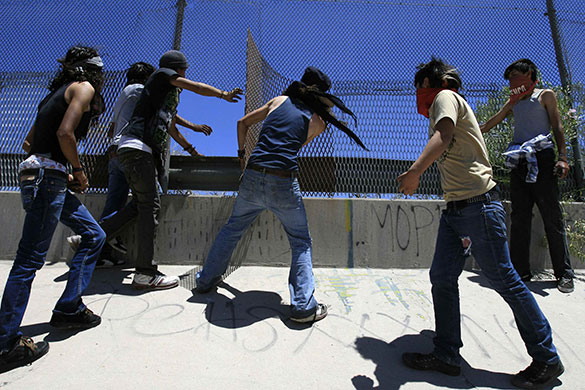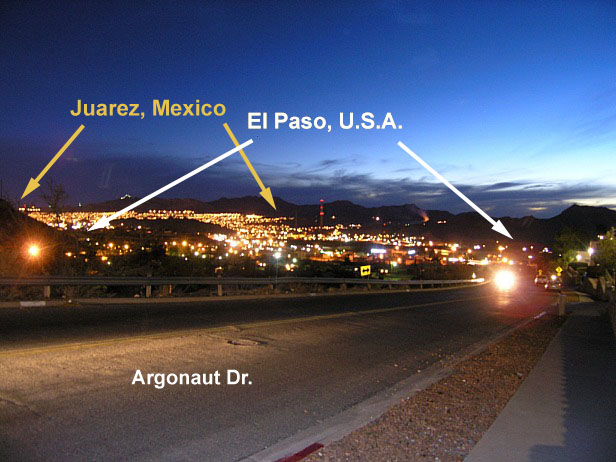Ciudad Juárez: The Architecture of Failure
From Domus with my addition of illustrations: An op-ed by Jose Castilo in Mexico City that says a lot about the similar problems with planning and design in African urban situations, which are also rather more often equally damaged by planning and interventions than helped:
Planners and architects are failing to imagine new protocols and forms of public space that could help stem the violence in Juárez, México
In the 1958 Orson Welles movie, a Touch of Evil, the main character, Mike Vargas, a Mexican Narcotics officer played by Charlton Heston, mutters, “all border towns bring out the worst in a country.” Though not set in a specific city, the depiction in the movie of an environment of corruption, violence, powerful drug lords and urban despair seems quite accurate to the current situation of Ciudad Juárez, México.
The current global perception of Mexico is one of a country at war with the big drug cartels—more than 30,000 people have died violent deaths since 2007—then Ciudad Juárez, opposite El Paso Texas is the poster child of that war. Juárez, with a population of 1.3 million, had 3,111 violent deaths in 2010. With a rate of 229 murders for every 100,000 inhabitants, Juárez is officially the most dangerous city in the world.
In one sense Juárez can be understood as an analog to Detroit, where its status as a failed city and its huge loss of population is the result of a combination of economic blight, social disintegration and drug-related violence. And like Detroit, it seems that neither politics, planning, or architecture can do anything to stop the decay. As Charles Bowden writes in his book Murder City, “it is not the collapse of the social order, it is the new order.”

Ciudad Juarez, Mexico: Demonstrators damage part of the US border fence
But violence has not taken place independently of space, but rather has manifested itself in specific forms of urbanity. In January of 2010, a commando murdered 17 teenagers in an area of Juárez called Villas de Salvacar. The site, a recently built but abandoned low-income development, is emblematic of the way that the physical stock of housing has depreciated and left to disarray. It is estimated that nowadays over 25% of the homes in Juárez are empty, with people fleeing either back to their original homes in other parts of México or migrating to the USA. These abandoned homes are predominantly regulated, planned anddesigned homes fostered by the state and built by developers.
In a different fashion, in some of the informal sectors of Juárez mostly built by its residents, the sense of belonging and the community has been more resilient, though not necessary less violent. The recent murder of seven young men in a public sport field part of a community center being built by the federal and local governments is evidence that violence has become geographically pervasive. On top of the gang violence, these settlements are more sensitive to environmental disasters, especially flash floods that can destroy homes and neighborhoods instantly.
On both sides of this spectrum, planning and design are failing in imagining protocols, designing environments and producing forms of public private space that can better address the needs of this city and this community.
While the federal government’s strategy against drug violence clearly includes the recovery of public spaces and the specific program for Ciudad Juárez has a strong spatial agenda, it is not clear yet how this will produce change. But what is truly surprising is the sense of detachment and autonomy from the disciplines of architecture and planning from the problems of city violence and other processes of a failing city. We seem to be spectators while everything goes up in flames, limiting ourselves to the liberal conventional wisdom of criticizing the “war on drugs” or making more or less intelligent remarks on the phenomenon. One could be tempted to argue about the limits of the professional practice in inducing change, producing civility and guaranteeing safety, but this sense of detachment has become suspicious.
And yet when one looks at certain key aspects of the reasons for the failure of Juárez, they are closely linked to a split between the physical and the social: It is those specific finished houses and neighborhoods that are being abandoned; it is those generic public spaces which are failing in reimagining community; it is that marginalizing geography of zoning, corridors and poverty which is engendering the failed city.
If space can be an instrument of conflict, politics and militarization, by the same token it could also be the agent of social change. Conditions like those in Juárez demand an architecture capable of reconstructing social cohesion through the transformation of space, its infrastructure, its urban landscape as a way to recover urbanity, security, civility and community.
One has to imagine the possibility to construct an urbanity that emerges from conflict; one where the physical and the designed are intimately connected with the social and the procedural, and where forms of empowerment can be induced through design. In a way, it is this rapport between civil society and spatial strategies that can reduce the violence.
Architecture’s sense of agency should come from strategies that include changing the decision-making process, challenging prevailing policies that reproduce the urban status quo, develop better forms of community participation and developing spaces that can foster human capital. The legitimacy of the discipline regarding space and aesthetics has to be embedded with a different model of social participation and sense of professional responsibility.
In a way, architecture’s current inability to (re)imagine engagement and participation is reflected in a kind of social irrelevance; the political deficit of the profession that Rem Koolhaas talks about. Against that, I argue for “critical optimism;” the possibility of engaging in these conditions, close to the forces and powers producing the city, and yet autonomous enough to remain reflexive and critical.
To (re)build the public realm in Juárez has becomes a disciplinary imperative. As Saskia Sassen has recently argued, cities can become technologies against war and violence. To make the most of that resiliency, architecture has to re-establish its own disciplinary agenda, so that unlike in A Touch of Evil, cities not only bring out the worst of countries, but also the best of them.
Jose Castillo is the co-founder, along with Saidee Springall, of arquitectura 911sc, a practice of architecture, urban design and planning based in Mexico City. arquitectura 911sc is currently involved in a master plan for a neighborhood in Ciudad Juárez. Castillo is member of the advisory board of Urban Age and LSE Cities and currently teaches at the Universidad Iberoamericana and at the University of Pennsylvania.




